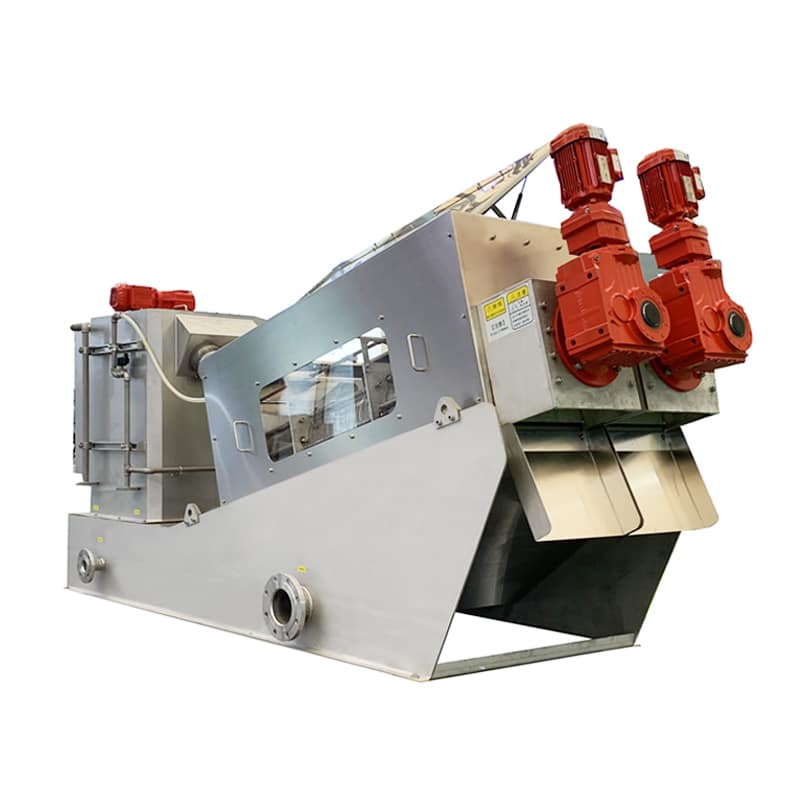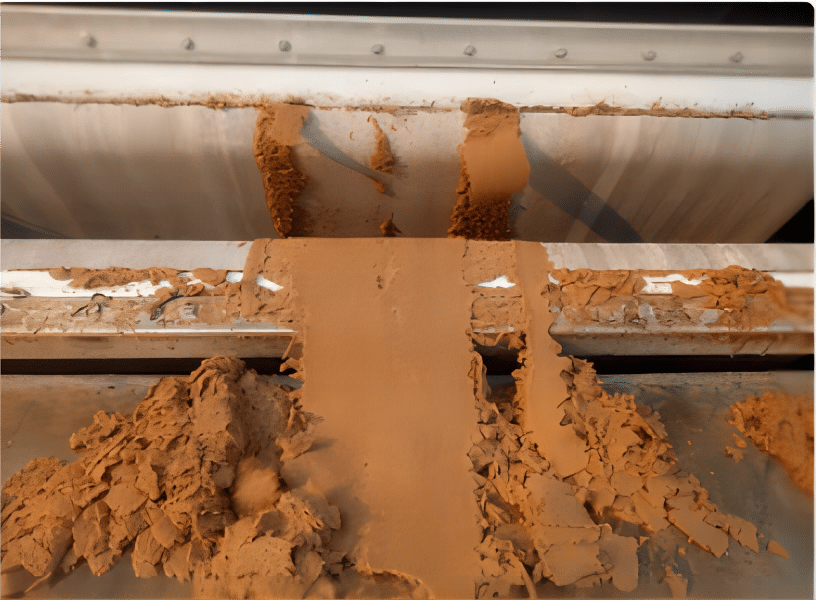Thickening is the first and often unavoidable step to reduce the amount of sludge extracted from the water mains. In fact, it is used to optimize the subsequent conditioning, stabilization and dewatering stages by reducing structural dimensions and operating costs.
What is sludge thickening?
Sludge thickening is the process of removing water from sludge produced during wastewater treatment so that the solid portion of the sludge becomes more concentrated, thereby reducing the volume and increasing the solids content.
Thickening incurs additional investment costs and can be cumbersome. However, this is largely offset by savings in downstream production lines.
- Reduce the size of anaerobic digesters or aerobic stabilization reactors.
- Elimination of thickeners downstream of the biostabilization process, thereby reducing the amount of contamination returned to the top of the plant.
- Selection of dilution sludge from primary settling tanks, thereby preventing fermentation in these structures, which produces foaming and swelling (linear bacteria) during the biological treatment process.
- Generally lower levels of conditioning upstream of dewatering.
- Increased throughput and reduced energy consumption of the dewatering unit.
- The reduction in pumping, transfer piping and any intermediate storage tanks (if applicable) is significant.
What is sludge from water treatment?
Sludge from water treatment is a solid mixture of suspended matter, organic matter, microorganisms, inorganic impurities and flocculant residues in the water deposited after settling, flocculation or biochemical treatment, and usually contains a large amount of water (more than 90% water content).
Why is sludge thickening?
- Volume reduction: Raw sludge usually contains a lot of water, making it bulky. By thickening, the water can be removed from the sludge, thus significantly reducing the volume of waste. This reduces the cost of treating, disposing and transporting the sludge.
- Increased solids content: The thickening process increases the amount of solids in the sludge, making it more concentrated. This is important for subsequent treatment steps as thickened sludge is easier to handle, dry and dispose of.
- Resource recovery: In some cases, it is possible to recover resources from sludge. Thickening sludge can make resource recovery more efficient, for example by recovering organics, metals or other reusable substances.
- Reduced risk of discharge: Thickening reduces the liquid fraction of the waste, thereby reducing the potential risk to the environment if the sludge is discharged. More concentrated sludge is easier to control and manage.
Why is sludge thickening important?
- Reduce volume and pressure for subsequent treatment
The initial water content of sludge is up to 95% or more, which makes direct treatment bulky and inefficient.
By thickening, the water content can be reduced to about 90% or less, which significantly reduces the burden on subsequent dewatering equipment and saves processing space and time. - Significantly lower operating costs
Thickened sludge is smaller in size, which means less transportation costs, lower energy consumption for dewatering and disposal, and less dosing, which is critical for controlling operating costs, especially in medium and large wastewater plants. - Upgrading dewatering and reprocessing
Concentration is a precondition for subsequent mechanical dewatering (e.g. belt filter press, centrifugal dewatering).
Inadequate thickening will lead to poor treatment effect of the dewatering machine, high wear and tear of the equipment, and failure to reduce the water content. - Contributing to resource utilization
- Anaerobic digestion for biogas production;
- Composting or fertilizer production;
- Incineration or drying;
Promote the realization of the goal of “reduction, harmlessness and resourcefulness” of sludge.
Sludge Thickening Working Process
Sludge treatment: First, sludge is typically generated from wastewater treatment processes, including primary, secondary, or advanced treatment stages of STP. Sludge collection typically involves removing sludge from settling tanks, settling basins, settlers or other wastewater treatment equipment. The sludge undergoes a series of pre-treatment steps that use primary screening to remove large particulate matter, impurities, and dispersible particles from the liquid. This helps to improve the efficiency of the subsequent filtration steps.
Gravitational Concentration
Gravity thickening involves the use of specially designed circular tanks to thicken dilute sludge into a denser sludge product. The limitation of this form of clarified water treatment is that it is mainly suitable for excess aqueous sludge produced in the activated sludge process. The thickening tank is equipped with slow moving vertical paddles. The sludge flows into the thickening tank and excess water is eventually removed from the solids collected at the bottom.
Dynamic thickening: Mechanical Thickening
Centrifugal Separation
Centrifugal dewatering of wastewater is centrifugal separation utilizes centrifugal force to separate the liquid from the sludge. The sludge is placed in a rotating centrifuge, and the rotation of the centrifuge generates a strong centrifugal force that separates the liquid from the sludge. It is a sludge thickening method that is suitable for a wide range of scenarios. They usually require less space than other sludge thickening methods, but usually they are not effective for primary sedimentation. They are suitable for highly thickened sludge and can quickly separate the liquid and solid phases. KUOSI screw press a new type of sludge extrusion and dewatering equipment, utilizes the screw extrusion principle to achieve sludge dewatering through the change in screw diameter and pitch produced by the strong extrusion pressure and the small gap between the floating ring and the fixed ring.

Air flotation Sludge Thickening
Dissolved air flotation is the primary system for sludge thickening. Small air particles attach to the suspended solid material. DAF Sludge cause the solids to break up and float to the surface. When air bubbles attach to these suspended solids, they have a lower gravity than water, which makes them float. These particles form a layer of sludge on the surface which can be removed and disposed of.
Filtration
The treated sludge is fed into a filtration plant, usually a filter or a filter press. These devices consist of a filter medium, such as filter cloths or filter plates, which allow the passage of liquids and prevent solid particles from passing through. KUOSI belt filter presses are suitable for most sludges, with a larger filtration area and a thicker sludge cake.

Rotary Drum Concentrator
Water flows from the surface of the drum and sludge is transported along the drum by a helical screw and finally discharged from the end of the drum. The sludge is guided inside and over the flow edge through the drum. The auger screw conveys the sludge along the drum and finally out of the drum. The auger screw slowly mixes the sludge inside the drum, thus efficiently discharging water from the sludge.
Chemical Concentration
Chemical thickening in sludge thickening is a method of reducing the water in sludge and increasing the solids content, where chemicals are used to induce the separation of water from the sludge. This method typically involves the use of one or more chemical clarifiers to improve solid-liquid separation for sludge thickening.
Collection of thickened sludge: The thickened sludge (solid fraction) remaining on the filter media is collected and usually subjected to further treatment or disposal, e.g., by drying, incineration or landfill.
Difference Between Concentration And Dehydration
Tickening
- Thickening is the reduction of water in sludge while maintaining a certain relative humidity, usually with the goal of increasing the solids content.
- The thickening process can be achieved by physical or mechanical methods such as centrifugal separation, filtration, and settling.
- The main objective of thickening is to reduce the volume of waste and increase the solids content in order to reduce treatment and disposal costs.
Dewatering
- Dewatering is the drastic reduction of water in sludge to very low moisture levels, usually with the goal of making the sludge drier.
- Dewatering usually requires higher levels of energy and equipment such as dewaterers, filter presses, or drying equipment.
- The main purpose of dewatering is to make the sludge into a solid mass or powder that can be easily handled, disposed of or recycled, while reducing the volume and weight of the waste.
Thickening and dewatering are both methods of treating sludge, but they have slightly different levels and objectives. Thickening aims to increase the solids content, but retains a certain level of moisture for easier handling and disposal. Dewatering, on the other hand, seeks a higher degree of water removal in order to obtain a dry solid residue, which is usually used for final treatment and disposal of the sludge.
Various Types Of Sludge Thickening Methods And Performance
| Sludge Type | Thickening Method | Performance |
| Sewage sludge | Centrifugal separators, filter presses, dewatering machines | Increase solids content, typically to 20-30% |
| Vacuum filtration, concentration centrifuge | Reduction of waste volume | |
| Chemical sludge | Filtration, sedimentation, press filtration, centrifugal separation | Increased solids content, typically to 15-25% |
| Industrial sludge | Sedimentation, dewatering machines, filter presses | Increased solids content, typically to 20-40% |
| Sewage treatment residues | Sedimentation, dewatering machines, filter presses | Increased solids content, typically to 15-25% |
Application Areas For Sludge Thickening
- Wastewater Treatment Plant
- Industrial Wastewater Treatment
- Agricultural Applications
- Municipal Sludge Treatment
- Energy Production
- Ecological Research
Summary
Sludge typically contains biosolids separated from liquid effluent. Sludge thickening is essential because it is a procedure used in wastewater treatment facilities to increase the concentration of solids. KUOSI, as a leading water treatment manufacturer in China with more than 16 years of rich experience in the field of wastewater treatment, offers sludge dryers, wastewater screens, aeration blowers, dosing systems, disinfection systems and grit removal equipment. Feel free to contact us.
